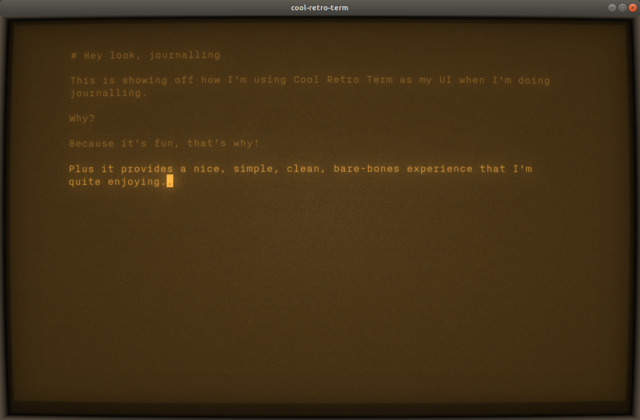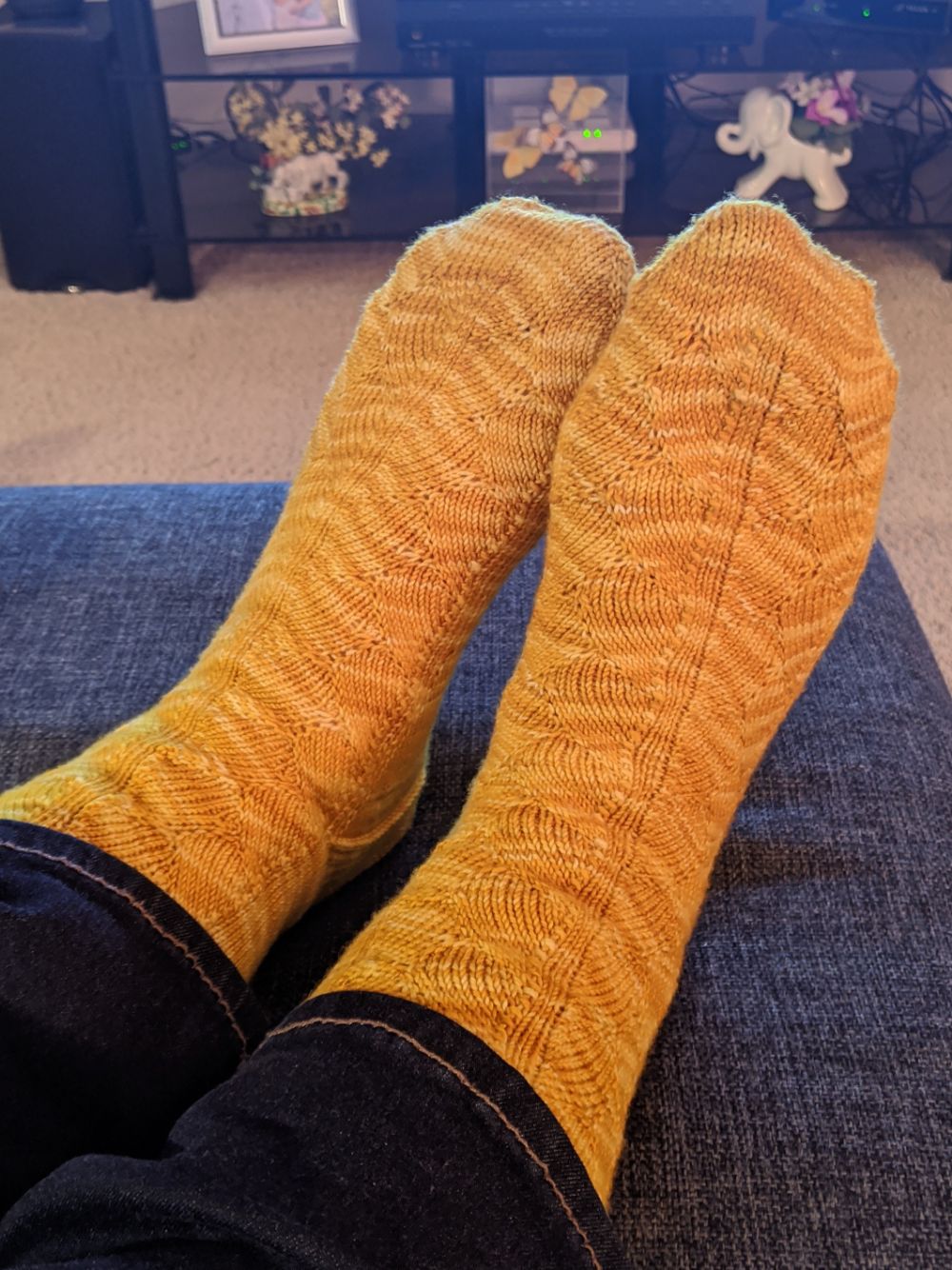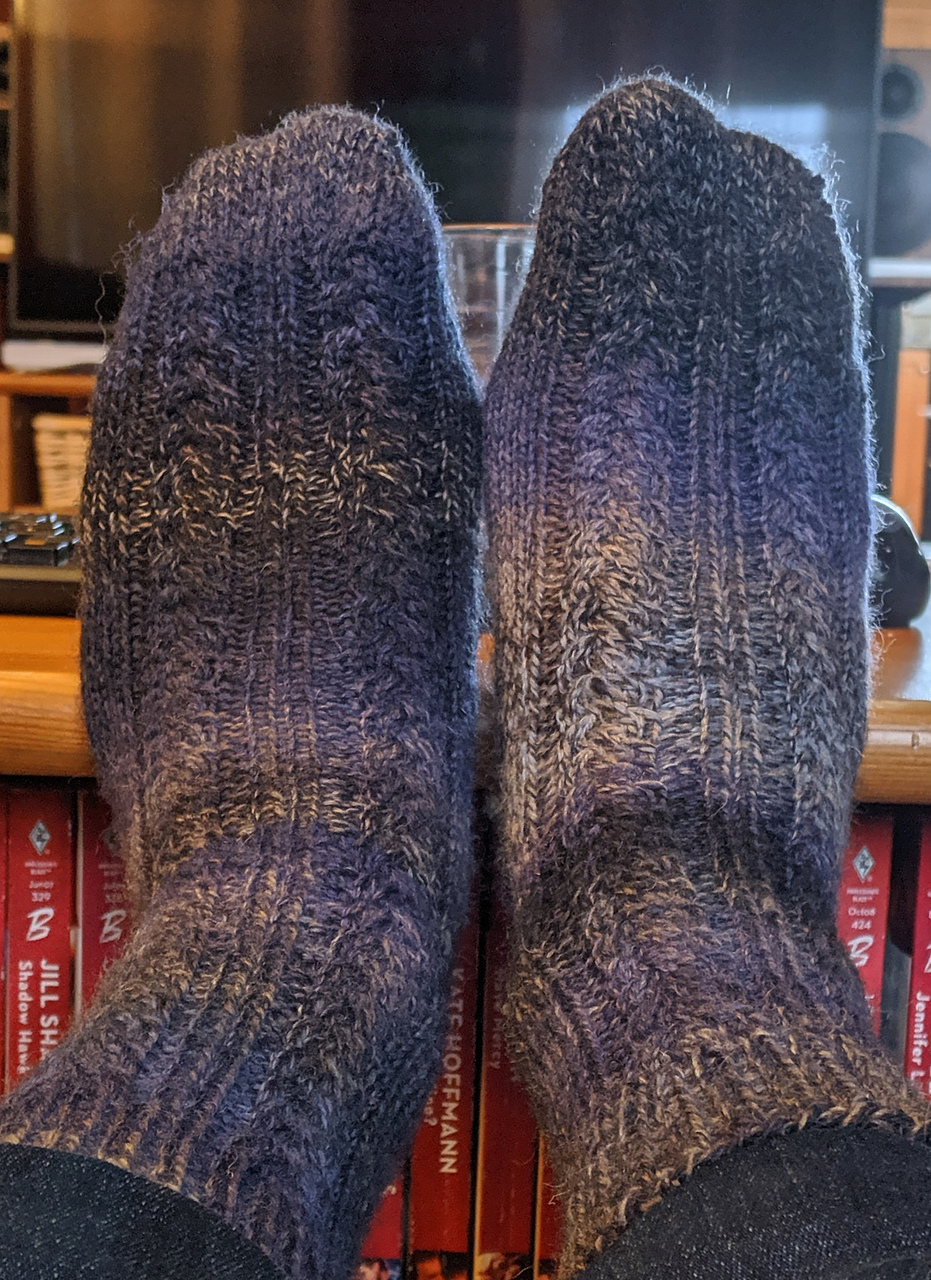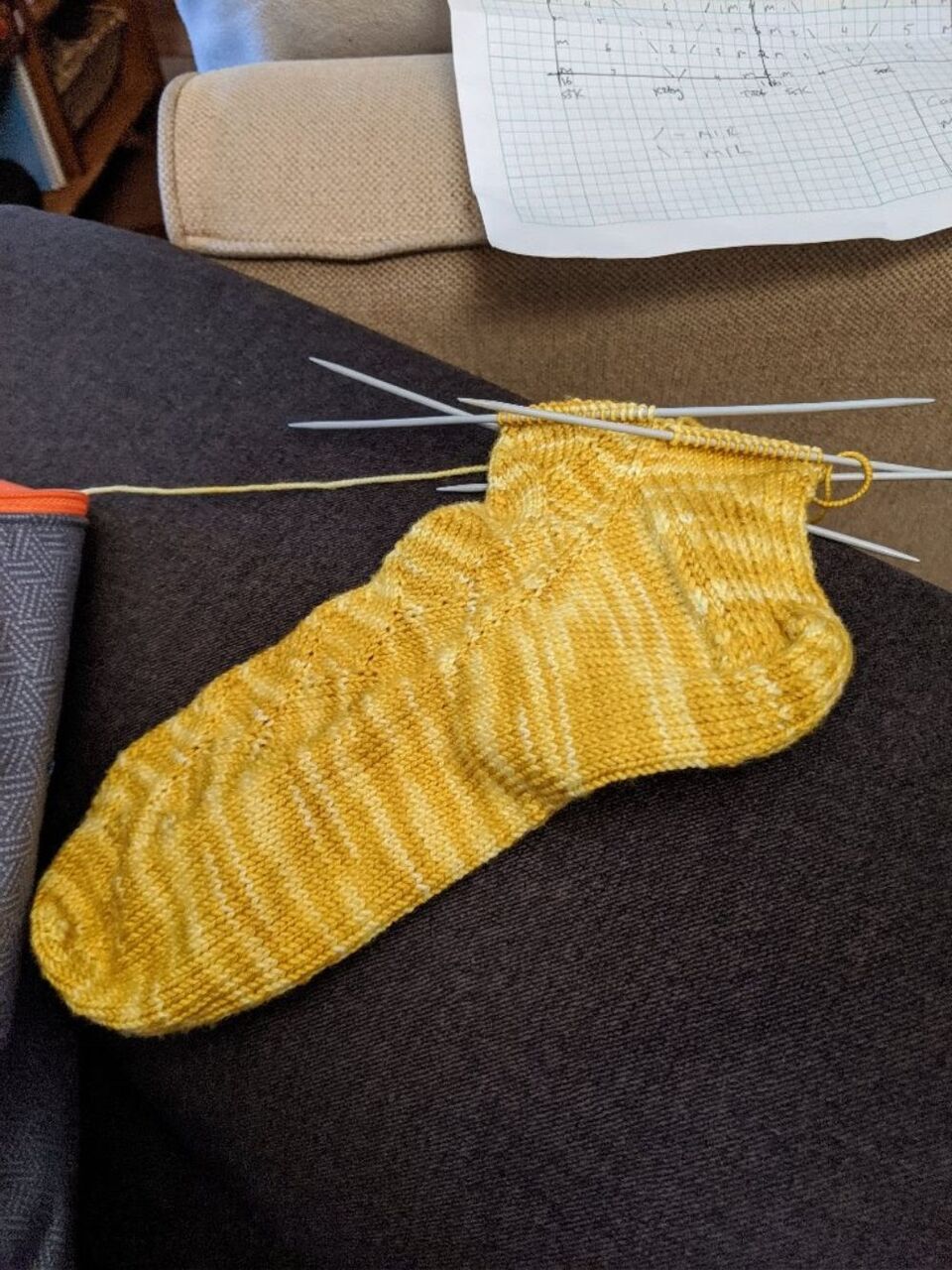- (https://b-ark.ca/ksKKwg)
I’m riding in the 2025 Enbridge Tour Alberta for Cancer, raising money for the Alberta Cancer Foundation, and have so far raised $2,744, exceeding my $2,500 goal and surpassing my 2024 effort!
Help me by donating here
And remember, by donating you earn a chance to win a pair of hand knitted socks!
- (https://b-ark.ca/wQcI2U)
For book start/finish posts I’m using IndieBookClub. For reviews, I’m just posting to my blog. Hopefully Brid.gy supports Goodreads syndication soon (and if not I’ll write that code myself)! Ravelry support would be amazing!
- (https://b-ark.ca/w0eSG6)
Taking back control of my content, I’m pulling my (modest) book reviews from Goodreads back to my blog. An underrated favourite of mine is Last Chance to See by the astounding Douglas Adams.
Fun with themes
For kicks I wanted to build a dark mode for my blog, which led me down the garden path of CSS custom properties and easter eggs…
One of the many things that attracted me to tech, back in the day, was the total DIY freedom of hacking computers to do whatever I wanted. And when you’re a kid, it’s even more fun because you aren’t looking at your pet projects through the lens of “value” or “product market fit” or “differentiators”. You just… do stuff, simply because it’s fun!
Or, put more simply: You play. And as adults, we have play beaten out of us. And that is just a darn shame.
Well, one of the fun things about running your own blog on your own server with software you control is that it’s a wonderful place to play! Heck, the re-design of this blog started off as just me screwing around for the fun of it.
So, while on vacation, I thought it would be fun to build a dark mode theme for my blog using the technique outlined in this post (which it turns out is one of many).
If you want to see the results… well, first off, if your OS is set to use a dark mode theme, you might already be seeing it! Otherwise, the little lightbulb icon in the navbar toggles the themes.
In addition, if you poke around in my site, you might find an easter egg that enables a couple of additional retro themes designed to honour the computers of the past that inspired me and lead me to where I am today!
Continue reading...- (https://b-ark.ca/uiA_sS)
Spotted someone reading the Enchiridion on the bus and I had to fight not to strike up a conversation about Stoicism…
- (https://b-ark.ca/w68emQ)
Just finished listening to @karaswisher interview @msurman on Recode Decode about @Mozilla. Mark’s comments about the need to split data gathering from exploitation immediately made me think of the Indieweb…
- (https://b-ark.ca/uqOOEW)
I’m officially signed up for the @RideToConquer! I’ve been meaning to do this for years, and with a push from a co-worker, and considering all of my friends and family affected, it was finally time. Get ready for begging!
- (https://b-ark.ca/6aweiS)
I use Vim+plugins for distraction-free writing. On a lark I added Cool Retro Term to the mix. And it’s amazing!
- (https://b-ark.ca/y4yC2S)
Speaking of surveillance, the EPS is looking at employing facial recognition technology. @bevesslinger, how are you ensuring the EPS has proper oversight in their use of this technology?
- (https://b-ark.ca/4WQCm6)
More proof that surveillance capitalism is everywhere, and laws like CCPA and GDPR can’t come too soon. @Cooper4SAE, what are you doing to push for an enhanced privacy regime in Canada?
My Cup Of Tea Socks (Reversed)
A quick write-up of my process for converting a cuff-down sock pattern to toe-up as part of my most recent project.
I absolutely love making socks. As a project, they’re relatively quick, by now very familiar, a small canvas for a bit of experimentation, and in the end, always useful. After all, who doesn’t need another pair of socks?
Unfortunately, that’s also caused me to amass quite the collection of sock yarn over the years. In fact, I spent a good part of 2019 making sock after sock after sock thanks to our indulging in a Michael’s Boxing Day sale back at the start of last year.
But, I’ll be the first to admit, the stash has been building up for a long time, now.
As a result, the yarn that I used in this project–a lovely, variegated yellow yarn who’s label I’ve apparently lost–has been sitting in my collection for a couple of years now, having been pushed down the queue by more recent acquisitions. However, I finally decided to do something with it!
Now, as a toe-up sock knitter, it’s always a bit trickier to find patterns, and so I’ve often settled for coming up with my own designs. However, this time, I decided to try my hand at converting an existing cuff-down pattern to toe-up.
These socks are based off of the My Cup of Tea Socks pattern (hosted on Ravelry), which I then altered, both to convert the pattern to toe-up, and to make the motif a bit larger.
Continue reading...- (https://b-ark.ca/iYakcY)
A little custom cable design that created a sock that’s just a tad too small…
- (https://b-ark.ca/A2yaQQ)
Another pair down! This yarn had been in my stash for a couple of years now, so it’s nice to get them done. Post to come with details, including how I converted this cuff down pattern to toe up.
- (https://b-ark.ca/QsmEmG)
Well, finally got around to enabling HTTPS on my blog after dragging my feet. I’m sure there’s still glitches to work out, but for the most part it seems to be working! Thanks @letsencrypt!
- (https://b-ark.ca/UiEMeu)
After finishing my DIY keyboard project (http://b-ark.ca/MIYO2i) I’ve been trying to decide what I want to try as my next hardware hacking project, and this is definitely on the list…
- (https://b-ark.ca/0sAK6O)
Well this is disturbing… we desperately need rigorous laws to protect personal privacy
- (https://b-ark.ca/g8WiCC)
Finished my first playthrough of the incredible remake of “Wonder Boy: The Dragon’s Trap” by @lizardcube. I’m a big fan of the original, and the remake is a remarkable piece of work!
Five years in Product - The Team
The third in a series on my years in product management. In this post I explore what it was like to help build a product team, and then work within it.
This is part three in a series on my career shift from software development to product management. If you haven’t read the preceding posts and you’re interested, you can start with part one!
When I first took on the role of Product Manager, it was basically a solo role. While I had plenty of support from our executive team, and a lot of help and direction from both my superiors and my colleagues, absent a dedicated staff, if things needed to be done, I either had to do them myself or trick others to do them for me!
On its face this might seem a bit crazy (and it was!), but it’s important to realize that, at the time, the company had not yet made the shift to an Agile Scrum development model. As a result, back then, if you had asked me to describe the Product Manager role, I would have described it as high-level and directional, while the actual day-to-day execution was being handled by my colleagues in various other departments, particularly development. As a result, a lot of my time was spent on bigger picture stuff: building roadmaps (badly), scoping releases, collecting and managing customer requests, general process development and refinement, and so on.
It’s also worth noting that, at the time, I don’t think any of us at the company had a clear picture of how to integrate a Product Management function into the company in a holistic way, not the least of which because, while this was only five years ago, the role was less defined than it is now. And as I mentioned in my first post, ultimately, layering Product Management as a function into an existing organization is an exercise in change management, and we were still figuring out what that meant.
Fortunately, Agile Scrum came along and gave us a model for how to integrate Product Management into software development in a coherent way: The Product Owner role. And if we were going to have Product Owners, those POs needed to get their direction from somewhere, and that somewhere could be the Product Management group (i.e. me)!
Continue reading...- (https://b-ark.ca/AcuCCA)
With the proliferation of IoT (aka “smart”) devices, the #Futurama episode “Mother’s Day”, where robot toasters and staplers revolt against humanity at the behest of a crazed dictator, is starting to feel eerily prescient…
- (https://b-ark.ca/_8sgmA)
That’s a good point! Given how nascent Webmention still is, I’m not sure the cost-benefit is there for me, yet, in adding backlinks for POSSE copies (my main goal is owning what I create), but maybe I’ll experiment with it!
- (https://b-ark.ca/g4OgkC)
A lot of things I post to Twitter start as notes on my blog so I host the content, but right now I don’t link back from the tweet to the note as I find it messy.
- (https://b-ark.ca/OUKkUS)
That moment when you realize you apparently knit too fast because you overshot the length of the sock you’re working on and now you need to tink a bunch of rows…
- (https://b-ark.ca/wyuuk0)
Well, I now have Jekyll automatically generating tagmojis from page categories in my feed to M.b. Mappings are configured in the site config and the rest is automagic!





